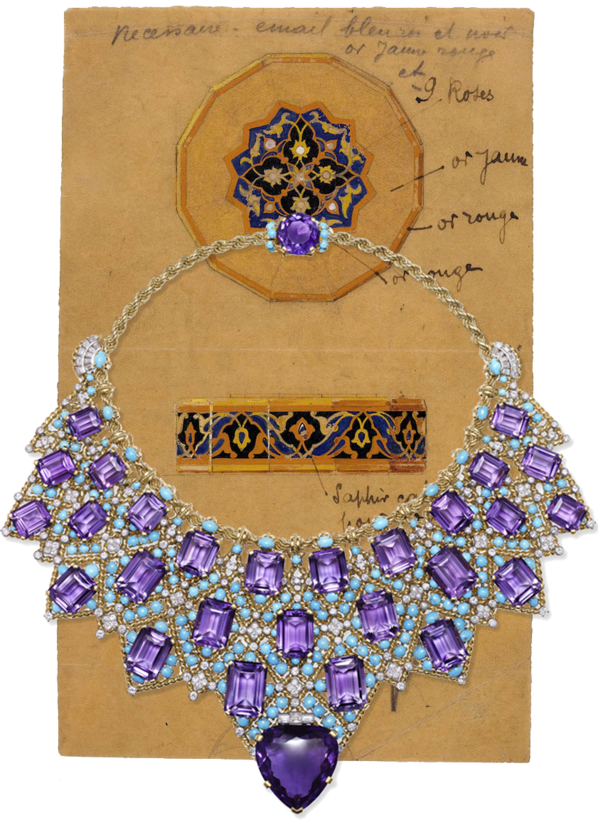While on a trip to Russia in 1911 to court new clients, Louis Cartier sent a letter to his father, Alfred, writing, “It seems to me that the selections of new items we should offer for sale must inevitably be the Russian or even Persian style.” By this time, Louis had been collecting Islamic art for several years, having seen the exhibition of Islamic art at the Musée des Arts Décoratifs in 1903, in Paris, and an important 1910 exhibition of Islamic art in Munich.
He was buying patterned Persian rugs, illuminated manuscripts, and gem-set objects such as hookahs and pen cases from Armenian antiquarian dealers, who were flowing into Paris from Turkey. He was also assembling a formidable library on the arts of the Near East and Far East, including such treasures as The Thousand and One Nights and Rubaiyat of Omar Khayyam, as well as The Grammar of Ornament (1856), Owen Jones’s illustrated design lexicon of Islamic forms and patterns.

For Louis, collecting was one side of the Cartier coin; the other was overseeing the Paris branch and its designers. (His younger brothers, Jacques and Pierre, ran the London and New York branches, respectively.) For the culturally enlightened, it was time to look for inspiration beyond the boundaries of one’s own country. Yet who would have imagined that change would come on the heels (or toes) of ballet slippers?
The Ballets Russes premiere of Schéhérazade, in Paris in 1910, upended conventional taste. Overnight, tout le monde became obsessed with all things Persian. Amped up by the color-saturated sensuality of Léon Bakst’s set and costume designs, Schéhérazade not only aroused Parisian audiences but influenced new design directions in fashion, music, interiors, and, of course, jewelry.
For Louis, the timing was kismet. Working with his head designer, the gifted Charles Jacqueau, and later with the great Jeanne Toussaint, he mined both his personal collection and that of Jacques, who had been in India acquiring fabulous gemstones and natural pearls, as the basis for an altogether new and modern art.
Authentic goods from Iran, India, and Japan were adapted in the Cartier workshop, resulting in an East-West aesthetic of stylized geometric forms—triangles, squares, lozenges—and a dazzling chromatic palette that paired lapis lazuli with sky-blue turquoise, emeralds with sapphires—what Louis described as “peacock décor.” Cartier’s new jewelry was catnip for the modern woman who sought liberation from Edwardian stuffiness.

The arches of a mosque courtyard showed up in a tortoiseshell bandeau of coral and onyx, today an iconic Cartier jewel. The tessellated design of a tiled mosque ceiling became the structure for one of the best-known Cartier creations, the amethyst-and-turquoise bib necklace, commissioned by the Duchess of Windsor in 1947. Color and shape, the modification of antique carved gemstones (worked into new showstoppers, especially the colorful Tutti Frutti pieces, famously owned by Daisy Fellowes), and the added flexibility of platinum resulted in some of the most important and striking jewels of the 20th century.
Under Louis, the House of Cartier became the leader in le style moderne, soon to be known internationally as Art Deco. Cartier was embracing the larger world and taking from it the timeless language of many cultures.
“Cartier and Islamic Art: The Search for Modernity,” opening later this month at the Musée des Arts Décoratifs, is poised to become one of the most sumptuous and deeply engaging jewelry exhibitions in recent memory. More than 400 objects are on view—among them 200 pieces of jewelry shown alongside rarely seen period photography, archival drawings, and printed matter, plus Islamic artworks that trace the myriad connections between inspiration and the finished jewel.
The exhibition is also a valentine to the collecting taste and force of Louis Cartier, whose Persian and Indian artifacts will be shown en masse for the first time in 80 years. Whether you will be in Paris or Dallas, where the exhibition opens in May of 2022, treat yourself to the superb accompanying catalogue, page for splendid page sure to become a collector’s item. —Ruth Peltason
“Cartier and Islamic Art” opens October 21 at the Musée des Arts Décoratifs, in Paris. It travels to the Dallas Museum of Art on May 14, 2022
The eponymous catalogue publishes from Thames & Hudson on April 12, 2022


 Discover
Discover